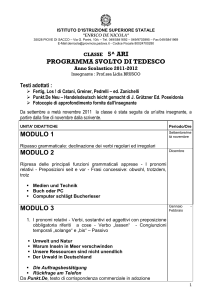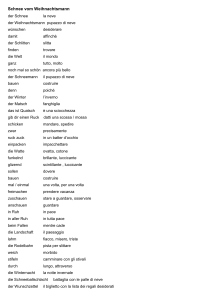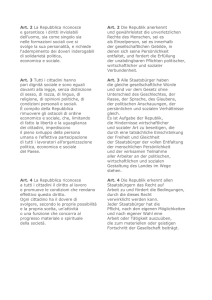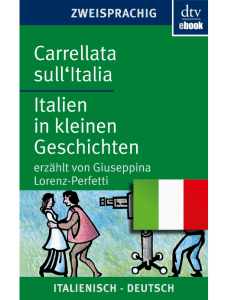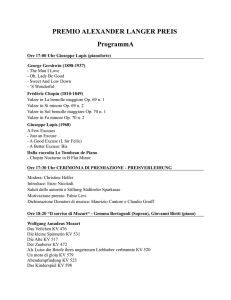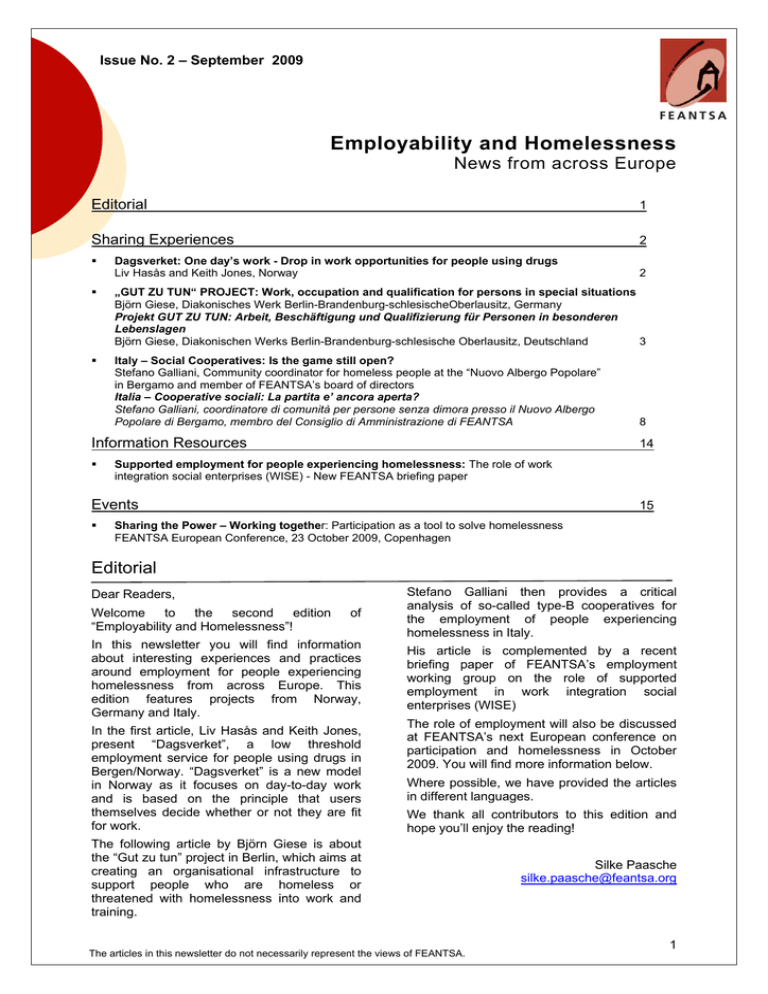
Issue No. 2 – September 2009
Employability and Homelessness
News from across Europe
Editorial
1
Sharing Experiences
2
Dagsverket: One day’s work - Drop in work opportunities for people using drugs
Liv Hasås and Keith Jones, Norway
2
„GUT ZU TUN“ PROJECT: Work, occupation and qualification for persons in special situations
Björn Giese, Diakonisches Werk Berlin-Brandenburg-schlesischeOberlausitz, Germany
Projekt GUT ZU TUN: Arbeit, Beschäftigung und Qualifizierung für Personen in besonderen
Lebenslagen
Björn Giese, Diakonischen Werks Berlin-Brandenburg-schlesische Oberlausitz, Deutschland
3
Italy – Social Cooperatives: Is the game still open?
Stefano Galliani, Community coordinator for homeless people at the “Nuovo Albergo Popolare”
in Bergamo and member of FEANTSA’s board of directors
Italia – Cooperative sociali: La partita e’ ancora aperta?
Stefano Galliani, coordinatore di comunità per persone senza dimora presso il Nuovo Albergo
Popolare di Bergamo, membro del Consiglio di Amministrazione di FEANTSA
Information Resources
14
Supported employment for people experiencing homelessness: The role of work
integration social enterprises (WISE) - New FEANTSA briefing paper
Events
8
15
Sharing the Power – Working together: Participation as a tool to solve homelessness
FEANTSA European Conference, 23 October 2009, Copenhagen
Editorial
Dear Readers,
Welcome to the second edition
“Employability and Homelessness”!
of
In this newsletter you will find information
about interesting experiences and practices
around employment for people experiencing
homelessness from across Europe. This
edition features projects from Norway,
Germany and Italy.
In the first article, Liv Hasås and Keith Jones,
present “Dagsverket”, a low threshold
employment service for people using drugs in
Bergen/Norway. “Dagsverket” is a new model
in Norway as it focuses on day-to-day work
and is based on the principle that users
themselves decide whether or not they are fit
for work.
Stefano Galliani then provides a critical
analysis of so-called type-B cooperatives for
the employment of people experiencing
homelessness in Italy.
His article is complemented by a recent
briefing paper of FEANTSA’s employment
working group on the role of supported
employment in work integration social
enterprises (WISE)
The role of employment will also be discussed
at FEANTSA’s next European conference on
participation and homelessness in October
2009. You will find more information below.
Where possible, we have provided the articles
in different languages.
We thank all contributors to this edition and
hope you’ll enjoy the reading!
The following article by Björn Giese is about
the “Gut zu tun” project in Berlin, which aims at
creating an organisational infrastructure to
support people who are homeless or
threatened with homelessness into work and
training.
The articles in this newsletter do not necessarily represent the views of FEANTSA.
Silke Paasche
[email protected]
1
Employability and Homelessness
Issue No. 2 – September 2009
Sharing Experiences
Dagsverket: One day’s work
Drop in work opportunities for people using drugs, Bergen, Norway
Liv Hasås and Keith Jones
Dagsverket (“One-day’s work”) is a low
threshold service aimed at providing people
who are addicted to drugs with a drop in work
opportunity in Bergen/Norway. The service
offers paid work to a group of 15 persons for
four hours a day. Participants receive their pay
at the end of the day. The pay is 50 kroner an
hour (≈ 5.50 euros) and is tax-free. These
earnings do not affect welfare benefits of the
participants.
Dagsverket started as a 3–year-project in
2004. In 2006 the project turned into a
permanent initiative. Dagsverket has become a
very popular service and runs at its capacity of
15 people almost every day. People have to
meet early in the morning to queue, and when
the doors open at about 8 o’clock, they sign in
on a list. In the premises of Dagsverket they
have the possibility to have some coffee, rest
and also access to the Internet before the work
starts at around 9 o’clock.
The work is organised in three groups. One
group stays in-doors and is responsible for
running a laundry service and doing the daily
clearing up and cleaning of the premises. Two
groups do out-door work, such as maintenance
work in council housing facilities and clearing
up in-doors and out-doors in housing
associations. There is a broad spectre of work
these two groups can do. However, it should
not be too demanding and it should not
compete with ordinary private enterprises who
offer similar services.
Dagsverket can offer suitable participants
different types of courses, such as lift and
chain saw courses, to qualify them for more
advanced maintenance work and to provide
them with certificates which may facilitate a
transition into similar jobs in the future.
Dagsverket is a new model in Norway as it
focuses on day-to-day work and is based on
the principle that users themselves decide
whether or not they are fit to work. The work is
offered independently from their engagement
with rehabilitation services and the obligation is
only for one day’s work at a time.
By April 2005 about 170 persons were
registered as users of the service, and a group
of about 35 persons were regular participants.
By May 2009, 369 persons have been
registered as participants of Dagsverket. The
proportion of women involved is relatively low
and has varied from 8 % in 2004, rising to 23
% in 2007 and then falling to 13 % in 2008.
The variation in age is significant – from 19 to
72 years. The average age is approximately 40
years.
Dagsverket is organised under the umbrella of
the Centre for vocational training (Senter for
arbeidslivsforberedelse, ALF as). This centre
offers training and supported employment to
vulnerable groups. Although Dagsverket
emphasises participants’ independence and
does not oblige people to engage with
rehabilitation services, there are good
possibilities to access organised rehabilitation
and vocational training in the Centre. It is part
of Dagsverket’s concept that only a minimum
of information of each participant is being
registered. There is therefore little information
about whether or not participants move on to
other activities or mainstream employment
after participating in Dagsverket. However,
there is anecdotal evidence that some
participants either move on to other
employment schemes run by the ALF or gain
some form of employment in the open labour
market.
A qualitative evaluation of Dagsverket was
conducted in 2006 based on the number of
participants, responses from participants and
responses from other co-operating health and
social services. The evaluation shows that
Dagsverket has become an important activity
for the target group and has been very loyal to
its initial idea to offer a low threshold and
unbureaucratic work opportunity to people.
Participants have managed to create a good
working environment within Dagsverket. This
means that there are little problems with
intoxication at work and people usually know
whether or not they are fit to work.
Dagsverket has been valuable for many of the
participants because it allows people to take
one step at a time and at their own pace. It has
2
Employability and Homelessness
Issue No. 2 – September 2009
given people who are excluded from ordinary
working life some of the economic, social and
psychological benefits of working. A number of
other Norwegian municipalities are now
copying the model in order to give people who
are using drugs the possibility for social and
vocational training
From July 2008 Dagsverket extended its
activity by organising a working group in
Nygårdsparken. This is an area in Bergen
where the majority of people who inject drugs
are found. There has been lots of media
attention regarding the presence of this group
in the park. To improve the conditions in the
area Dagsverket received funding to establish
a working group in the park two days a week.
The participants are recruited on site from one
of Dagverket’s vans. The work involves
collecting rubbish, used syringes etc. Working
hours and pay are the same as for the other
participants of Dagsverket. The new project
has helped to reinforce Dagverket’s low
threshold principle. The “park group” is also
available to those who do not manage to meet
up early in the morning to gain a place in the
traditional Dagsverket initiative.
Dagsverket is recognised by public authorities
as an important element of the drugs strategy.
There is a commitment to further invest in this
type of activity and the majority of funding for
Dagsverket is secured. However, the present
regulations for payment of statutory benefits
are a barrier. The employment agencies still
have to devise a permanent solution for the
issue of pay/remuneration to participants which
is not bureaucratic or liable for tax. These
forms of economic incentives for participants
are vital in order to both maintain an effective
strategy for the target group of socially
excluded and further develop the good work of
Dagsverket.
Projekt GUT ZU TUN
Arbeit, Beschäftigung und Qualifizierung
für Personen in besonderen Lebenslagen
„GUT ZU TUN“ PROJECT
Work, occupation and qualification for
persons in special situations
Björn
Giese,
Existenzsicherung
und
Integration des Diakonischen Werks BerlinBrandenburg-schlesische Oberlausitz e.V.,
Berlin
Björn Giese, Sustenance and Integration,
Diakonische
Werk
Berlin-Brandenburgschlesische Oberlausitz e.V., Berlin
Das Projekt GUT ZU TUN des Diakonischen
Werk
Berlin-Brandenburg-schlesische
Oberlausitz e.V. hat das Ziel, eine
organisatorische Infrastruktur dafür zu
schaffen, um in Berlin innerhalb von drei
Jahren ca. 500 wohnungslose Menschen oder
von
der
Wohnungslosigkeit
bedrohte
Menschen, in Arbeit, Beschäftigung oder
Qualifizierung zu bringen. Das Diakonische
Werk vertritt dabei nicht nur den Standpunkt,
dass ein großer Anteil dieser Menschen in
Arbeit, Beschäftigung und Qualifizierung
eingegliedert werden kann, sondern dass
jeder
dieser
Menschen
nach
dem
„Würdegrundsatz“ ein Recht auf Arbeit hat.
GUT ZU TUN arbeitet seit Mai 2008. Das
Projekt wird sowohl finanziell als auch in der
praktischen
Arbeit
vom
Berliner
Immobilienunternehmen
ESTAVIS
AG
unterstützt. Eine weitere Unterstützung erfolgt
durch den Europäischen Sozialfond. Die
konkreten Aufgabengebiete gliedern sich in
zwei Teilbereiche. Auf der einen Seite soll
eine
nachhaltige
organisatorische
Infrastruktur für wohnungslose Menschen
geschaffen werden, um für sie einen
The aim of the “GUT ZU TUN” project of the
Diakonische
Werk
Berlin-Brandenburgschlesische Oberlausitz e.V. is to create an
organisational infrastructure so as to be able
to get some 500 people who are homeless or
who are threatened with homelessness to
work, occupation and qualification. In so
doing, the charity not only adopts the view
that a large part of these people can be
placed in work, occupation and qualification,
but also that each one of these people has a
right to work in accordance with the “dignity
principle.” GUT ZU TUN has been active
since May 2008. The project is supported
financially but also on practical matters by the
Berlin-based real estate firm ESTAVIS AG. It
also receives support from the European
Social Fund. Its concrete tasks are divided
into two sections: On the one hand, to create
a sustainable infrastructure for homeless
people so as to guarantee them a separate,
regulated institutional access to the labour
market. The competence and networking of
institutions and services working with the
homeless in Berlin are to be strengthened and
supported. On the other hand, the people
concerned are to be given individual help.
3
Employability and Homelessness
Issue No. 2 – September 2009
gesondert geregelten institutionellen Zugang
zum Arbeitsmarkt zu gewährleisten. Die
Einrichtungen und Dienste der Berliner
Wohnungslosenhilfe
sollen
in
ihrer
Kompetenz und Vernetzung im Bereich
Arbeit, Beschäftigung und Qualifizierung
gestärkt und unterstützt werden. Auf der
anderen Seite sollen die betroffenen
Menschen eine individuelle Hilfe erhalten.
Die Prozesse, die durch das Projekt initiiert
werden, lassen sich wie folgt unterteilen und
beschreiben:
The processes initiated through the project
can be divided and described as follows:
Strukturelle Prozesse:
Hinwirken auf das Schaffen eines
gesondert
geregelten
institutionellen
Zugangs zum Arbeitsmarkt für den
Personenkreis
Unterstützung
der
Träger
der
Wohnungslosenhilfe bei der Entwicklung
und
dem
Aufbau
innovativer
Arbeitsprojekte
Untersützung der Einrichtungen der
Wohnungslosenhilfe
bei
der
Antragstellung und Administrierung von
Maßnahmeplätzen
über
spezifische
regionale Förderinstrumente wie z. B.
öffentlich
geförderte
Beschäftigungsmöglichkeiten (Öffentlicher
Beschäftigugssektor)
Unterstützung
und
Förderung
der
Arbeitsprojekte bei der Vernetzung und
Kooperation mit den Einrichtungen und
Diensten der Berliner Wohnungslosenhilfe
Individuelle Hilfen:
Akquise von Maßnahmeplätzen bei den
bestehenden Programmen
Akquise von Arbeitsplätzen in der freien
Wirtschaft
Aufbau einer Datenbank von Klienten der
Berliner
Einrichtungen
der
Wohnungslosenhilfe, die potenziell zu
Arbeit,
Beschäftigung
oder
eine
Qualifizierung in der Lage sind
Vermittlung
der
Klienten
gewonnenen Einsatzstellen
Aufbau, Koordination und Administrierung
eines Coaching- und Lotsensystems für
Härtefälle
an
die
Ein wichtiger Baustein des Projektes ist eine
Datenbank, in der Klienten aus den
Structural processes:
Work towards creating a separate
regulated institutional access to the labour
market for the people concerned;
Support institutions and services working
with people experiencing hoemlessness
in developing and expanding innovative
employment projects;
Support
institutions
working
with
homeless people in applying for and
administering job and training placements
through specific regional promotional
instruments such as, e.g. publicly
supported
employment
opportunities
(public employment sector);
Support and promote employment
projects
through
networking
and
cooperation with the institutions and
services working with people experiencing
homelessness in Berlin.
Individual help:
Help find places in existing programmes;
Help find jobs in the open economy;
Build a database of clients of institutions
working with the homeless who are
potentially capable of being placed in
work, occupation or qualification;
Place the client in the positions obtained;
Create, coordinate and
coaching and guidance
hardship cases.
manage a
system for
One important component of the project is a
database of clients of institutions working with
the homeless in Berlin, who have the potential
of being placed in work, occupation or
qualification. This database is based on a sort
of profiling according to which the
corresponding clients are entered with their
socio-demographic data, data on previous
occupational
history,
any
additional
qualifications, an assessment of their aptitude
and similar categories. This database can be
used to search actively for appropriate
applicants for situations vacant.
After almost a year in operation, the project
can be said to be drawing near its goal. 116
homeless people had by August 2009 been
4
Employability and Homelessness
Issue No. 2 – September 2009
Einrichtungen
der
Berliner
Wohnungslosenhilfe erfasst werden, die
potenziell für Arbeit, Beschäftigung oder
Qualifizierung in Frage kommen. Grundlage
dieser Datenbank ist eine Art Profiling, durch
das die entsprechenden Klienten mit
soziodemografischen Daten, Daten über ihren
bisherigen beruflichen Lebensweg, eventuelle
Zusatzqualifikationen,
Einschätzung
der
Leistungsfähigkeit und ähnlichen Kategorien
erfasst sind. Auf Grundlage dieser Datenbank
ist es möglich, aktiv geeignete Bewerber für
offene Stellen zu finden.
Nach fast einem Jahr Projektlaufzeit lässt sich
placed in work, employment and qualification.
An extensive mix of occupational relations
and activities carried out has emerged (see
Figure). Thus, such people are not placed
exclusively in what are known as 1-Euro jobs
(1) or qualification schemes, but a large
proportion of them are placed on the regular
labour market. This shows that many
companies and employment institutions in
Berlin are prepared to commit themselves for
these people. Employers make partial use of
state promotional instruments. Several Berlin
companies were however also prepared to do
entirely without the support and subsidies of
Verteilung der vermittelten Personen/
Distribution of persons placed according to the form of
employment
8%
1. Arbeitsmarkt/ open labour
market
MAE Arbeitsgelegenheit mit
Mehraufwandsentschädigung
/ work opportunity with
financial compensation
ÖBS/ publicly supported
employment
13%
BEZ/ other supported
employment
48%
Ehrenamtliches
Engagement/ Volunteering
17%
1%
Qualifikation/ Training and
edcuation
sonstige Fördermaßnahme/
Other employment support
initiative
8%
5%
bereits festhalten: Das Projekt nähert sich
seinem Ziel. Es konnten bis August 2009 116
Menschen
des
angesprochenen
Personenkreises in Arbeit, Beschäftigung und
Qualifizierung vermittelt werden. Es ist ein
breiter Mix an Beschäftigungsverhältnissen
und ausgeführten Tätigkeiten entstanden
(siehe Abbildung). So wurden die Personen
nicht ausschließlich in sogenannte 1-Eurojobs
(1)
oder
Qualifizierungsmaßnahmen
vermittelt, sondern es konnte ein großer Anteil
der Personen auf den 1. Arbeitsmarkt
vermittelt werden. Dabei zeigt sich, dass viele
Berliner
Unternehmen
und
Beschäftigungsträger bereit sind, sich für
diese Menschen zu engagieren. Teilweise
werden von den Arbeitgebern staatliche
Förderinstrumente benutzt. Mehrere Berliner
Unernehmen waren aber auch dazu bereit,
ganz auf Förderungen und Zuschüsse der
the Job Centre, and to provide regular jobs for
homeless
people.
These
are
both
remunerated full-time jobs, as well as minor
employment relationships.
The Public
Employment Sector Promotional Instrument
(known by the German initials “ÖBS”), which
is specific to Berlin, could be used often for
clients. The target group of the ÖBS consists
of the long-term unemployed, and employers
are provided with a nearly full (100%) wage
subsidy for the gross labour costs incurred for
the employee.
The ensuing employment
relationships are remunerated at least in
accordance with the required minimum wage
(€7.50/hour). This employment programme is
expected to bolster (broken down) social
infrastructure.
It has become moreover clear that a
considerable portion of the clients is
5
Employability and Homelessness
Issue No. 2 – September 2009
JobCenter zu verzichten und stellten reguläre
Arbeitsplätze für den Personenkreis zur
Verfügung. Hierbei handelt es sich sowohl um
tariflich vergütete Vollzeitstellen, als auch um
geringfügige
Beschäftigungsverhältnisse.
Auch das Berlin spezifische Förderinstrument
Öffentlicher
Beschäftigungssektor
(ÖBS)
konnte vielfach für die Klienten genutzt
werden. Die Zielgruppe von ÖBS sind
Langzeitarbeitslose und es bietet dem
Beschäftigungsgeber einen nahezu 100
%igen
Lohnkostenzuschuss
der
Arbeitnehmerbruttokosten. Die entstandenen
Beschäftigungsverhältnisse
werden
mindestens
nach
dem
geforderten
Mindestlohn (7,50 €/Stunde) entlohnt. Durch
dieses Beschäftigungsprogramm soll die
(weggebrochene)
soziale
kommunale
Infrastruktur gestärkt werden.
Es wurde außerdem deutlich, dass ein
erheblicher Teil der Klienten den festen Willen
hat, sich wieder in das Arbeitsleben zu
integrieren. Und was noch viel erfreulicher ist:
Es wurde deutlich, dass der überwiegende
Tei der Personen in der Lage ist, einer
speziell auf ihre Bedürfnisse ausgerichteten
Arbeit oder Beschäftigung dauerhaft über
einen längeren Zeitraum nachzugehen.
Es
wird
insgesamt
ein
Frauenanteil
angestrebt, der den Anteil der Frauen, in der
für
dieses
Projekt
anzusprechenden
Zielgruppe widerspiegelt. Dabei ist von einem
Frauenanteil von ca. 35 % auszugehen.
Erfahrungsgemäß
sind
weibliche
Wohnungslose höher qualifiziert als die
männlichen Wohnungslosen.
Dementsprechend sollen die vorhandenen
Qualifikationen der Frauen gezielt gefördert
werden. Bisher ist es gelungen einen
Frauenanteil von rund 20 % zu erreichen, was
noch nicht ganz den Zielen entspricht, diesen
jedoch nahekommt.
Probleme
Bei der Umsetzung des Projektes wurden
jedoch auch einige „hausgemachte“ (Berliner)
Systemproblematiken sichtbar. So gibt es für
Wohnungslose
und
für
von
Wohnungslosigkeit bedrohte Menschen in
Berlin
keinen
gesondert
institutionell
geregelten
Zugang
zum
Arbeitsmarkt.
Landes-, Bezirks- und Arbeitsverwaltung sind
in der Organisation der Hilfen unzureichend
aufeinander abgestimmt. Menschen in dieser
Lebenslage fallen in der Regel genau auf die
Schnittschnelle zwischen Arbeitslosengeld
(Leistungen
nach
dem
Deutschen
Sozialhilfgesetz
(SGB)
II)
und
Sozialhilfeleistungen (Leistungen nach dem
determined to be re-integrated in the world of
work. What is even more pleasant is that it
has become clear that the majority of these
people is capable of doing a job or occupation
geared specially to their needs over a long
period.
The aim is to have a proportion of women that
reflects their proportion of the target group to
be addressed for this project. This proportion
can be assumed to be around 35%.
Experience has shown that homeless women
are more qualified than their male
counterparts.
Accordingly, the available
qualification of women will be promoted in a
purposeful manner. Up to now, a proportion
of women of about 20% has been reached,
which does not yet correspond entire to the
targets, but does approach them.
Problems
A number of “home-made” (Berlin) system
problems became visible upon implementing
the project. For instance, there is no separate
institutionally regulated access to the labour
market for homeless people or for those
threatened with homelessness. State, district
and labour authorities are insufficiently intercoordinated in organising aid. People in this
situation generally fall precisely on the point of
intersection between unemployment benefit
(according to the German Social Welfare Act
(SGB) II) and social welfare benefits
(according to the German Social Welfare Act
(SGB) XXII), responsible for the various
positions. One particular consequence of this
is that instructional support on work cannot be
provided by the institutions working with
homeless people, because each of the two
authorities lays the responsibility on the other.
Concrete,
framework
agreements
are
therefore urgently needed. The institutions
and
services
working
with
people
experiencing homelessness in Berlin could
provide the instructional support for work,
occupation and qualifications accordingly.
The project is financed by the European
Social Fund and with proprietary funds of the
Diakonische Werk Berlin Brandenburg
Oberlausitz. Once the project and its
accompanying model phases have been
completed, financing must be provided
through national financial support or support
from the State of Berlin.
Conclusion
Previous experience with the project has
already provided proof that, in spite of the
multiple problems faced, a large portion of the
people concerned is capable of holding a
regular job, if it is in line with the individual
6
Employability and Homelessness
Issue No. 2 – September 2009
Deutschen Sozialhilfegesetz (SGB) XII), für
die
jeweils
unterschiedliche
Stellen
verantwortlich sind. Die Folge daraus ist
unter anderem, dass eine pädagogische
Begleitung zum Thema Arbeit durch die
Einrichtungen der Wohnungslosenhilfe nicht
geleistet werden kann, da sich die beiden
Leistungsträger
die
Verantwortung
gegenseitig zuschieben. Es müssen noch
dringend konkrete Rahmenvereinbarungen
fixiert werden. Die Berliner Einrichtungen und
Dienste der Wohnungslosenhilfe könnten
hiernach die pädagogische Begleitung bei der
Arbeit, Beschäftigung und Qualifizierung
leisten. Die Finanzierung des Projektes erfolgt
durch ESF-Mittel und Eigenmittel des
Diakonischen Werks Berlin Brandenburg
Oberlausitz.. Nach Auslaufen des Projektes
und der damit einhergehenden Modelphase,
muss eine Finanzierung über nationale
Zuwendungen oder Zuwendungen des
Landes Berlin gewährleistet werden.
Fazit
Durch die bisherigen Erfahrungen des
Projektes konnte schon jetzt der Nachweis
darüber erbracht werden, dass ein großer Teil
der betroffenen Menschen trotz seiner
multiplen Problemlage dazu fähig ist, einer
regelmäßigen Beschäftigung nachzugehen,
wenn
sie
auf
die
individuellen
Ressourcenvoraussetzung abgestimmt ist. Es
bleibt jedoch festzuhalten, dass das Projekt
GUT ZU TUN eine Lücke füllt, die es
eigentlich gar nicht geben dürfte. Die
Vermittlung in Arbeit, Beschäftigung und
Qualifizierung sowie die pädagogische
Betreuung dabei sind nach der Gesetzeslage
ureigene Aufgaben der zuständigen Stellen
für Arbeitslosengeld und Sozialhilfe. Die
Schnittstellenproblematik
zwischen
den
beiden zuständigen Behörden (SGB II und
XII) darf für eine umfassende und nachhaltige
Integration der Betroffenen nicht länger
ungelöst bleiben. Damit die Betroffenen
endlich wieder GUT ZU TUN haben, bleibt für
alle anderen Beteiligten auch weiterhin GUT
ZU TUN!
resource prerequisites. The fact remains, that
the “GUT ZU TUN” project fills a gap that
should actually not have been there.
Placement
in
work,
occupation
and
qualification as well as in instruction
supervision to that end constitute, pursuant to
the legislation in force, specific tasks of the
competent authorities for unemployment and
social welfare benefits. The problem of the
point of intersection between the two
competent authorities (SGB II and XII) must
not remain unsolved any longer for the sake
of a comprehensive and sustainable
integration of the people concerned. So that
the people concerned can have “GUT ZU
TUN” again, “GUT ZU TUN” will continue also
for all other persons involved!
(1) A "1 Euro Job" is a job with the help of which the
government wants to (re)integrate in particular the longterm unemployed in the regular labour market. The aim
of such jobs is to keep recipients fit to work, provide them
with regular employment, and get them used to a
structured daily routine. Income from a “one euro job” is
not taken into account for unemployment benefit or other
benefits.
(1) Ein "1 Euro Job"ist eine Arbeitsgelegenheit, mit deren
Hilfe die Regierung vor allem Langzeitarbeitslose wieder
in den ersten Arbeitsmarkt integrieren will. Sie haben den
Zweck, die Arbeitsfähigkeit aufrecht zu erhalten und
sollen den Empfänger an regelmäßige Arbeit und einen
strukturierten Tagesablauf gewöhnen. Einkommen, die
aus einem "Ein Euro Job" erzielt werden, werden auf das
Arbeitslosengeld oder andere Leistungen
nicht
angerechnet.
7
Employability and Homelessness
Issue No. 2 – September 2009
Italia – Cooperative sociali: La partita e’
ancora aperta?
Italy – Social Cooperatives: Is the game
still open?
Stefano Galliani, Nuovo Albergo Popolare di
Bergamo,
membro
del
Consiglio
di
Amministrazione di FEANTSA
Stefano Galliani, “Nuovo Albergo Popolare” in
Bergamo and member of FEANTSA’s board
of directors
La Costituzione dichiara nel suo art. 1 che
“l’Italia è una Repubblica fondata sul lavoro”:
principio irreale per molti cittadini diventa pura
illusione per le persone senza dimora (psd).
Infatti non c’è adeguato diritto che promuova
e garantisca un reale accesso all’occupazione
per tutti. Questa situazione ha determinato la
nascita di un movimento fortemente
innovativo di auto organizzazione della
società civile con la creazione delle prime
cooperative di solidarietà sociale (intono al
1975). Nel corso degli anni questa forma
imprenditoriale si ulteriormente sviluppata,
perdendo però gran parte della spinta
innovativa. I fattori di questo processo sono
molteplici: la risposta del sistema pubblico di
welfare ai bisogni sociali è rimasta fortemente
carente; contemporaneamente gli enti pubblici
hanno utilizzato le cooperative sociali per
gestire una quota crescente di servizi sociali,
sanitari, educativi vincolando però il
movimento in termini progettuali e di
dipendenza economica.
In ogni caso la cooperazione sociale
rappresenta comunque uno dei principali
attori nell’intervento di reinserimento sociale
con le psd, soggetti fragili ed esclusi dal
mercato del lavoro.
Article 1 of the Italian Constitution states that
“Italy is a Republic based on the principle of
work” – an unreal principle for many citizens
that becomes pure illusion for people
experiencing homelessness. In fact, there is
no adequate legislation that promotes and
guarantees real access to employment for all.
This situation has led to the emergence of a
highly innovative movement of selforganisation by the civil society with the
creation of the first social solidarity initiatives
(as of 1975). This entrepreneurial form has
developed through the years, but has lost a
large part of its innovative drive in the
process. There are many reasons for this:
the response of the public welfare system to
social needs has remained largely wanting;
the public authorities have concurrently used
social cooperatives to manage a growing
share of social, health and educational
services, thereby constraining the movement
in terms of planning and economic
dependency. In any event, social cooperation
represents one of the underlying principles of
social reintegration for homeless people who
are vulnerable and excluded from the labour
market.
Definizione di cooperativa sociale
L’enorme sviluppo della cooperazione sociale
ha portato lo Stato nazionale a regolamentare
questo movimento: la Legge 381 del 1991
definisce la loro specificità nel "perseguire
l'interesse generale della comunità alla
promozione umana e all'integrazione sociale
dei cittadini attraverso”:
- la gestione di servizi socio-sanitari ed
educativi (cooperative di tipo A);
- lo svolgimento di attività diverse agricole, industriali, commerciali o di
servizi
finalizzate
all'inserimento
lavorativo di persone svantaggiate
(cooperative di tipo B).
Definition of social cooperative
The enormous development of social
cooperation has compelled the national
government to regulate this movement: Act
381 of 1991 stipulates that the specific
purpose of social cooperatives is to “serve the
public interest of the community for the
promotion of humanity and the integration of
citizens, through:”
- The management of social, health and
educational services (cooperative type A);
- The development of various activities –
agricultural, industrial, commercial or
services – geared to integrating
disadvantaged people in the world of work
(cooperative type B).
In particolare per cooperativa sociale di tipo B
si intende una cooperativa che impiega nella
produzione una forza lavoro composta da
almeno il 30% di lavoratori “svantaggiati”. I
dati più recenti (1) ci dicono che:
- la percentuale di soggetti svantaggiati
presenti in cooperativa rispetto al totale
dei lavoratori, si attesta, al 55,5 per cento,
Social cooperative type B in particular is
intended as a cooperative that employs a
workforce in production composed of at least
30% of “disadvantaged” workers. The most
recent data (1) show that:
- The
percentage
of
disadvantaged
persons in social cooperatives in regard
to the total number of workers amounts to
8
Employability and Homelessness
Issue No. 2 – September 2009
-
superiore al limite di legge
le cooperative di tipo B in Italia sono
2.419 (il 32,8% del totale delle
cooperative sociali)
Il lavoro nel reinserimento sociale delle
psd
E’ utile una premessa di carattere generale
sull’inserimento lavorativo delle psd. Con le
persone che si inquadrano nelle categorie
ETHOS 1 e 2 dobbiamo necessariamente
pensare ad una serie di servizi in grado di
svolgere alcuni passaggi prioritari e
consequenziali:
- accogliere ed elaborare una domanda di
aiuto confusa e poco progettuale
- ricollocare il bisogno di lavoro dentro una
prospettiva biografica globale
- accompagnare questi processi con il
recupero delle necessarie basi amministrative
- solo successivamente costruire percorsi
formativi e professionali praticabili dalla
persona.
Questo a dire che il focus del percorso si
colloca “dentro” la persona e non nel puro
recupero di opportunità lavorative accessibili
come nel caso, ad esempio, di un percorso
migratorio dove il focus è da subito nella
capacità di attivare risorse “esterne” alla
persona per favorire il suo progetto di vita.
Alla base di un progetto di reinserimento
sociale di una psd è quindi fondamentale
ridefinire il ruolo del lavoro nell’esperienza
concreta del presente. Spesso nella
rappresentazione dei soggetti e dei servizi la
dimensione lavorativa sembra essere la
soluzione
alla
multidimensionalità
dei
problemi, senza tener conto di alcuni fattori,
quali ad esempio:
- difficoltà di ordine amministrativo (es.
assenza di documenti)
- investimento sul lavoro trascurando
l’assenza di
relazioni significative per il
soggetto, problema che non può essere
colmato solo da lavoro e reddito
- condizioni psico-fisiche compromesse.
Il primo passo nel percorso di reinserimento
lavorativo è recuperare attraverso un lavoro
educativo quelle pre-condizioni individuali per
ricucire lo “strappo” tra persona e mondo del
lavoro. Il rischio di una prematura
ricollocazione occupazionale è l’abbandono
da parte del soggetto e la ricaduta nel disagio,
con l’aggravante di un nuovo fallimento
(biografico). Accanto a questo è necessario
un lavoro sociale che ridia cittadinanza alla
psd attraverso l’uso di appropriati servizi di
-
55.5%, higher than the limit set by law;
There are 2,419 type B cooperatives in
Italy (32.8% of all social cooperatives).
The work to re-integrate homeless people
into society
A few preliminary remarks on the general
nature of the re-integration of homeless
people into the world of work would be useful.
For people who fall under category ETHOS 1
and 2 (European Typology of Homelessness
and Housing exclusion), we must necessarily
think about a series of services capable of
enabling certain priority and consequential
approaches, namely to:
- receive and process a confused and not
very coherent request for help;
- reallocate the need for work according to an
overall background profile;
- provide advice and support for these
processes and establish the necessary
administrative bases
- only then define feasible training courses
and employment options for the person
concerned.
In other words, the focus of the process must
be “internal,” i.e. the person, and not on
seizing the opportunity for accessible
employment as, for example, in the case of a
migratory process where the focus is on the
capacity for a rapid activation of resources
“external” to the person, so as to promote that
person’s life project.
A plan for the re-integration of a homeless
person into society essentially entails
redefining the role of work in the concrete
experience of the present. The employment
dimension often seems to be a solution to the
multidimensional nature of problems when
considering people and services, without
taking into account any such factors as:
- difficulties of an administrative nature
(e.g. lack of documents);
- investment in employment that overlooks
the lack of any significant relevance for
the person, a problem that cannot be
overcome solely through employment and
income;
- impaired physical and mental conditions.
The first step in the process of re-integration
in the world of work is to restore, through
education, the individual preconditions for
mending the “breach” between an individual
and the world of work. The risk of premature
occupational reallocation is that the person
concerned will quit and become unemployed
9
Employability and Homelessness
Issue No. 2 – September 2009
sostegno (ad es. servizi specialistici sulla
salute) e il recupero dei documenti necessari
per poter accedere al lavoro.
Successivamente, in base alle risorse fisiche,
psichiche ed anagrafiche della persona è
possibile orientarsi ad un percorso di
carattere formativo - professionale e/o di
carattere occupazionale.
Opportunità offerte dalle cooperative di
tipo B
I percorsi di inserimento lavorativo con le psd,
sono
generalmente
supportati
da
amministrazioni pubbliche locali o, talvolta, da
servizi specialistici (salute mentale), dentro
luoghi di lavoro cosiddetti ”protetti”. Talvolta il
primo luogo “protetto” è la stessa
organizzazione che si occupa dell’accoglienza
alloggiativa; in altri casi ci si avvale di partner,
in genere cooperative sociali di tipo B. Le
cooperative dovrebbero fornire insieme alla
postazione di lavoro un accompagnamento
educativo che favorisca nella persona il
recupero di competenze spendibili sul
mercato dal lavoro a partire da quelle più
elementari: la capacità di entrare in un circolo
produttivo fatto di tempi, impegni, strutture
organizzate in unità di lavoro e gestite
secondo una gerarchia di responsabilità, la
continuità nel prestare la propria opera, la
tolleranza alla fatica, all’attesa del compenso,
alle frustrazioni di risultati non sempre
brillanti.
Accanto a questo lavoro educativo si colloca il
rimborso economico attraverso uno strumento
largamente diffuso, la cosiddetta “borsa
lavoro”. Si tratta di un benefit assegnato
attraverso specifici capitoli di spesa dei servizi
pubblici
e/o
finanziamenti
di
legge.
Nell’importo della “borsa lavoro” non vi sono
contributi a fini previdenziali o pensionistici. In
generale l’importo varia tra 100 e 500 Euro
mensili. La “borsa lavoro” non può essere
direttamente legata al monte ore di lavoro
svolto e nemmeno alla professionalità
richiesta ma semplicemente si definisce come
rimborso spese a fronte dell’impegno posto
dalla persona nel rispetto del contratto
stipulato. Obiettivo prioritario della “borsa
lavoro” non è fornire una professionalità
definita ma aiutare il soggetto a raggiungere
quei pre-requisiti necessari all’inserimento nel
mondo del lavoro (dipendente).
Le persone sono impiegate in diversi ambiti:
laboratori di assemblaggio, servizi a favore
della comunità locale (custodia parchi,
attraversamento pedonale bambini, ecc.),
raccolta e riciclo di materiali di scarto civile o
again, with an added (personal) failure to
boot. Social work is also needed that restores
a civic awareness to the person experiencing
homelessness through the use of appropriate
support services (e.g. specialised health
services) and the obtaining of the documents
needed to be able to access employment.
Then, based on the physical, mental and
personal resources of the person concerned,
a training – vocational training and/or
occupational approach - can be charted.
Opportunities
cooperatives
offered
by
type
B
The efforts to integrate people experiencing
homelessness into the world of work are
generally supported by the local public
authorities or, sometimes, by specialised
(mental health) services, in what are known
as “protected” workplaces. At times, the first
such “protected” workplace is the very
organisation
geared
to
providing
accommodation; in other cases, partners are
brought in, in general type B social
cooperatives.
The cooperatives should
provide, together with the work placement,
educational advice and support to help the
person recover skills that are marketable on
the labour market, starting with the most
elementary:
a capacity to enter in a
productive cycle consisting of time, tasks and
structures organised in work units and
managed in accordance with a line of
responsibility, the continuity to perform one’s
duties, tolerance to fatigue, in anticipation of
recompense and the frustrations of results
that are not always brilliant.
Alongside this education work is an economic
compensation through a widely disseminated
instrument known as the “work bursary”
(borsa lavoro). This is a benefit allocated
through specific budget items of the public
services and/or legislated funds. The amount
of the “work bursary” does not include social
security and pension contributions. This
amount varies in general between €100 and
€500 per month. The “work bursary” cannot
be linked directly to the hours of work
performed, nor to the qualifications required,
but is defined simply as a reimbursement of
expenses incurred for the commitment
undertaken by the person in compliance with
the signed contract. The primary objective of
the “work bursary” is not to provide a defined
qualification but to help the person meet the
pre-requisites to integration into the world of
(gainful) employment.
Such persons are employed in various fields:
10
Employability and Homelessness
Issue No. 2 – September 2009
industriale, facchinaggio
gestione del “verde”, ecc..
e
nei
traslochi,
I limiti delle cooperative di tipo B
L’attuale crisi economica ha solo aggravato
un processo in atto da tempo: la “borsa
lavoro”, intervento a carattere transitorio,
diventa di fatto l’unico reddito per un periodo
medio-lungo in una situazione occupazionale
che non può/riesce ad evolvere. Questo a
causa di limiti della persona (ad. es. patologia
invalidante, limiti cognitivi, compromissione
fisica, età anagrafica, ecc.), spesso per la
difficoltà dei servizi di mediazione (2) a
recuperare una “vera” occupazione alla
persona nel libero mercato del lavoro. Le
aziende “profit” hanno scarsa ricettività verso
adulti con una biografia “difficile” e risorse
psico-fisiche limitate.
Le stesse cooperative hanno scarsi contatti
con le aziende “profit” e non esistono processi
formalizzati di ricollocazione in aziende “profit”
attraverso tirocini svolti in cooperative sociali
di tipo B. Il contatto tra cooperativa e azienda
“profit” sta nella destinazione alle cooperative
di processi produttivi marginali (ad es. tutto
ciò che riguarda il settore delle pulizie civili e
industriali)
generando
paradossalmente
nuove forme di esclusione per i bassi redditi
prodotti e la precarietà dei contratti praticati.
Aggiungiamo che seppure la legge 381/91
stabilisca
alcuni
canali
preferenziali
nell’acquisizioni di lavori che permettano alla
cooperativa di assolvere al suo compito
sociale (art. 5) come accordi privilegiati con le
Amministrazioni locali che superano il
concetto della gara di appalto al miglior
ribasso, queste modalità ancora poco
praticate dagli Enti pubblici. Le cooperative
sociali si confrontano quindi sul mercato, in
concorrenza con le aziende “profit”. Questo di
fatto crea un paradosso: in una legislazione
che sempre più spinge sulla “flessibilità” del
lavoro, per riuscire a competere sul mercato
le cooperative sociali devono avere esigenze
sempre più “rigide” verso i lavoratori, con
richieste di competenze professionali e
disponibilità orarie che provocano l’esclusione
delle persone più “fragili”.
Infine le cooperative sociali, anche per le
ragioni sopra esposte, non sempre sono in
grado di garantire l’accompagnamento
educativo e progettuale necessario al
soggetto svantaggiato. L’inserimento quindi
diventa
puramente
incentrato
sulla
dimensione
lavorativo/professionale
determinando, talvolta il rischio di fallimento.
assembly workshops, services for the local
community (upkeep of parks, helping children
cross roads, etc.), the collection and
processing of household and industrial waste,
porterage and moving services, “green”
management, etc.
Limits of type B cooperatives
The current economic crisis has only
aggravated an ongoing situation for some
time now: the “work bursary,” an action of
transitional nature, becomes de facto the sole
income during a medium-long period in an
occupational situation that should not extend,
but risks doing so. This is because of the
limits of the person (e.g. disabling disorder,
cognitive limits, physical frailty, age, etc.),
often owing to the difficulty encountered by
mediation services (2) to find “real”
employment for the person on the labour
market. Companies “for profit” are rarely
interested in adults with a “difficult”
background and limited mental and physical
resources.
The same cooperatives have scarce contacts
with companies “for profit” and there are no
formalised procedures for placement in such
companies “for profit” through training
imparted in type B social cooperatives.
Contacts between cooperatives and “profitmaking”
companies
are
geared
to
cooperatives
of
marginal
production
processes (e.g. everything to do with the
household and industrial cleaning sector),
which paradoxically generate new forms of
exclusion owing to the low income and
precarious nature of the contracts involved.
We should add that even though Act 381/91
establishes certain preferential channels for
employment outlets that enable cooperatives
to fulfil their social role (article 5) such as
preferential agreements with the local
authorities that go beyond the concept of
awarding a contract to the lowest bidder,
these procedures are not resorted to very
frequently by the public authorities. The social
cooperatives are thus faced with competition
from companies “for profit” on the market.
This creates a paradox: given that legislation
is increasingly geared to “flexibility” in
employment, to compete successfully on the
market social cooperatives have to set
increasingly more “rigid” requirements on
workers in terms of skills and availability that
lead to the exclusion of the more “vulnerable”
persons.
Finally, social cooperatives, also for reasons
already outlined, are not always capable of
11
Employability and Homelessness
Issue No. 2 – September 2009
Ostacoli all’inserimento di soggetti senza
dimora nelle cooperative di tipo B
A quanto detto va aggiunto che l’utilizzo delle
cooperative per l’inserimento di psd non è
sempre facile. Il loro grande sviluppo non ha
portato sostanziali benefici alle psd che
rimane una “categoria” sottorappresentata tra
le persone “svantaggiate” inserite nelle
cooperative sociali.
Nell’ultima rilevazione ISTAT (3) i soggetti
inseriti nelle cooperative di tipo B (poco più di
30.000 persone) sono così suddivisi su base
nazionale:
providing the necessary guidance and
planning to a disadvantaged person.
Integration is therefore purely focused on the
employment/occupational dimension, which at
times proves decisively for the risk of failure.
-
utenti con disabilità fisica, psichica o
sensoriale 46,4% (4)
-
utenti tossicodipendenti 16,%
-
pazienti psichiatrici 15%
Obstacles to the integration of homeless
persons in type B cooperatives
In addition to the foregoing, using
cooperatives to integrate people experiencing
homelessness is not always an easy matter.
The extensive development has not brought
substantial benefits to the homeless who
continue to be an under-represented
“category” among the “disadvantaged”
persons integrated in social cooperatives.
According to the latest ISTAT report (3), the
persons integrated in type B cooperatives
(numbering a little over 30,000) break down
as follows nationwide:
-
detenuti ed ex-detenuti 8,7%
-
-
disoccupati 3,8%
users with physical, mental or sensorial
disability 46.4% (4)
-
alcolisti 4,3%
-
drug addicted users 16.%
-
utenti minorenni (con meno di 18 anni)
0.7%
-
psychiatric patients 15%
-
detainees and former detainees 8.7%
altri utenti 5.2%
-
unemployed persons 3.8%
-
people with alcohol addiction 4,3%
-
underage users (under 18) 0.7%
-
Come si vede le psd non sono considerati
come “categoria protetta” (5). La condizione di
svantaggiato è certificata principalmente da
servizi di carattere sanitario, con modalità di
accesso e pratiche amministrative complesse;
inoltre questi servizi hanno spesso scarsa
capacità di comprensione della specificità
della condizione di psd.
Per questo
avrebbero un ruolo fondamentale i servizi
sociali territoriali (comunali) che, però,
raramente si assumono l’onere di certificare le
psd con uno svantaggio sociale. La
certificazione di svantaggio è necessaria alla
cooperativa per attivare la “borsa lavoro” e
per godere dei benefici fiscali previsti dalla
legge.
Infine un limite che emerge spesso è legato
alle caratteristiche professionali e attitudinali
richieste dalle cooperative ai soggetti in
quanto la competizione sul mercato richiede
competenze di livello medio-alto. Buone
condizioni
psico-fisiche,
possibilità
di
raggiungere autonomamente postazioni di
lavoro anche lontane tra loro, patente
automobilistica,
competenze
tecnico/professionali specifiche: queste sono
solo alcune delle richieste usuali che, come
evidente, non sempre collimano con le
caratteristiche delle psd e riducono il numero
di inserimenti possibili.
other users 5.2%
Homeless
people
are
therefore
not
considered as a “protected category.” (5) The
condition of being “disadvantaged” is certified
chiefly by health services, and entails
complex
access
procedures
and
administrative practices; furthermore, these
services often do not have the capacity to
deal
with
the
specific
aspects
of
homelessness.
For
this
reason,
a
fundamental role should befall territorial
(municipal) services which nonetheless rarely
assume the burden of certifying people
experiencing homelessness with a social
disadvantage. Such disadvantage certification
is necessary for the cooperative to activate
the “work bursary” and to enjoy the tax
benefits provided by the law.
-
Finally, a restriction that often surfaces has to
do with the occupational skills and attitude
required by cooperatives from individuals
inasmuch as competition on the market
requires medium-level skills. A good mental
and physical condition, the ability to reach
workplaces independently even when far off,
driving licence, specific technical/occupational
skills: these are only some of the usual
requirements which evidently cannot always
12
Employability and Homelessness
Issue No. 2 – September 2009
Come superare le difficoltà di inserimento
lavorativo?
1. aumentare i servizi e le opportunità di
accompagnamento sociale per le psd in
un ottica di lavoro sul complesso delle
biografie e non solo sulla dimensione
lavorativa;
2. ristabilire per legge uno strumento
economico
e
progettuale
di
accompagnamento delle persone in
condizione di disagio sulla scorta della
sperimentazione del Reddito Minimo di
Inserimento (6) realizzata all’inizio di
questo decennio;
3. FioPSD (7) da tempo sta conducendo una
battaglia perché la certificazione di
svantaggio venga “formalmente” allargata
a tutte le psd in carico ai servizi del
“privato sociale”, specie a coloro che
possiedono una residenza fittizia che di
fatto identifica la condizione di grave
svantaggio sociale al di la di patologie o
disabilità invalidanti
4. urge una riforma dei servizi di mediazione
che sappia connettere il mercato del
lavoro “profit” con le fasce di persone in
condizione di svantaggio per un effettiva
connessione tra economia sociale e
“profit”
5. è necessario che gli organi amministrativi
competenti garantiscano il rispetto della
Legge 68/99 e di ogni provvedimento che
favorisce l’inserimento lavorativo dei
soggetti in disagio;
6. le cooperative sociali di tipo B devono
trovare al loro interno e nelle loro
rappresentanze
quella
capacità
contrattuale con l’amministratore (locale,
nazionale) che le faccia uscire dall’area
economicamente
e
contrattualmente
marginale che sempre più occupano; in
questo modo potranno fornire occasioni di
lavoro più numerose e congrue rispetto
alle caratteristiche di svantaggio dei
soggetti ridiventando quello strumento
innovativo di carattere sociale e lavorativo
come agli inizi del loro sviluppo.
tie in with the characteristics of people
experiencing homelessness, thereby reducing
the integration possibilities.
How to overcome the difficulties of integration
into the world of work?
1. Increase the services and opportunities
for social advice and support of people
experiencing homelessness with a view to
employment based on the overall profile
and no only on the occupational
dimension;
2. Re-establish, by law, an economic and
planning instrument for providing advice
and support to disadvantaged persons on
the basis of experiments with the
guaranteed minimum income (6) carried
out at the beginning of this decade;
3. FioPSD (7) has long waged a battle to
have disadvantage certification become
“formally” extended to all homeless
people attended to by services in the
“private social sector,” like those who
have a fictitious address, which de facto
identifies a serious condition of social
disadvantage beyond disorders or
disability;
4. Urge a reform of the mediation services
capable of connecting the employment
market “for profit” with the segments of
disadvantaged persons for an effective
connection between the solidarity-based
economy and the economy “for profit.”
5. The competent administrative authorities
must guarantee compliance with Act
68/99 and every provision that promotes
the integration of disadvantaged persons
into the world of work;
(1) Le cooperative sociali in Italia – rapporto ISTAT 2008
(su dati riferiti al 2006)
6. Type B social cooperatives must find,
within their ranks and in their
representation, such contractual capacity
with the (local, national) authorities that
enables them to get out of the
economically and contractually marginal
areas that they occupy more and more; in
this way, they will be able to provide more
employment opportunities that are more
in
tune
with
the
disadvantage
characteristics of the persons concerned,
and thus become again the innovative
social and occupational instrument that
they were at the outset.
(2) ad esempio in Lombardia e Veneto sono stati istituiti
SIL, NIL,UOIL, servizi gestiti dalle ASL e/o dai comuni
associati con l'obiettivo di supportare gli utenti nel
percorso di inserimento al lavoro, attraverso la
costruzione di programmi individualizzati e mirati alle
esigenze specifiche del soggetto, per accompagnarlo
nell'ingresso del contesto aziendale più adatto alle sue
(1) “Le cooperative sociali in Italia” [Social Cooperatives
in Italy] –ISTAT Report 2008 (data referring to 2006).
(2)In Lombardy and Veneto, for instance, work placement
and other such services have been established and are
managed by the local health authority or by the
municipalities concerned to provide support to the users
13
Employability and Homelessness
Issue No. 2 – September 2009
caratteristiche
(3) Le cooperative sociali in Italia – rapporto ISTA 2008 –
pag. 49
(4) La legge 68/99 stabilisce che i soggetti con disabilità
fisica, psichica o sensoriale riconosciuti con una
percentuale di riduzione della propria capacità lavorativa
pari o superiore al 46% da una commissione medica
abbiano accesso facilitato e mirato all’occupazione
attraverso appositi canali
(5) “Persone svantaggiate. - 1. Nelle cooperative (…) si
considerano persone svantaggiate gli invalidi fisici,
psichici e sensoriali, gli ex degenti di istituti psichiatrici, i
soggetti in trattamento psichiatrico, i tossicodipendenti, gli
alcolisti, i minori in età lavorativa in situazioni di difficoltà
familiare, i condannati ammessi alle misure alternative
alla detenzione (…)”.
(6) Ricordiamo che in Italia, a livello nazionale, non esiste
nessuna misura di Reddito Minimo; ci sono
sperimentazioni solo in alcune regioni (es. Campania)
(7) FioPSD – Federazione Italiana degli Organismi per le
Persone Senza Dimora : www. fiopsd.org
for their integration into the world of work through the
definition of individualised programmes geared to the
specific requirements of the person concerned, and to
provide support for integration in employment more in line
with his or her characteristics.
(3) Le cooperative sociali in Italia [Social Cooperatives in
Italy] –ISTAT Report 2008 – page 49
(4) Act 68/99 stipulates that persons with physical, mental
or sensorial disability found to have a reduced capacity
for work of 46% by a medical committee, are provided
easier access to employment through appropriate
channels.
(5) “Disadvantaged persons. - 1. In cooperatives, (…)
disadvantaged persons are considered to be those with
physical, mental or sensorial disability, former patients of
psychiatric institutions, persons undergoing psychiatric
treatment, drug addicts, alcoholics, minors of working age
in difficult family situations, detainees released under
alternative programmes (to detention) (…)”.
(6) It should be borne in mind that no minimum income
measure exists at national level in Italy; experiments were
carried out only in certain regions (e.g. Campania).
(7) FioPSD, Federazione Italiana degli Organismi per le
Persone Senza Dimora [Italian Federation of
Organisations Working with the Homeless]:
www.fiopsd.org
Information Resources
Supported
employment
for
people
experiencing homelessness
The role of work integration social enterprises
(WISE) - New FEANTSA briefing paper
Emploi aidé pour les personnes sans
domicile Le rôle des entreprises sociales
d’insertion par le travail (WISE) – Nouveau
document d’information de la FEANTSA
This briefing paper provides a critical analysis
of the social economy and in particular socalled work integration social enterprises
(WISE) for the employment of people
experiencing homelessness. The paper has
been
developed
by
the
FEANTSA
employment working group.
Ce document propose une analyse critique
des entreprises sociales d’insertion par le
travail (WISE) dans la promotion de l’emploi
des personnes sans domicile. Le document a
été développé par le groupe de travail sur
l’emploi de la FEANTSA.
It demonstrates the advantages of WISE in
providing transitional employment as well as
long term employment and occupational
activities
for
disadvantaged
workers.
However, it highlights that, due to the set up
of WISE and their funding, many people
experiencing homelessness are still de-facto
excluded from participation.
Le document démontre les avantages des
WISE pour offrir un emploi transitoire ainsi
qu’un emploi à long terme et des activités
occupationnelles
pour
les
travailleurs
défavorisés. Toutefois, il souligne qu’en
raison de l’organisation de WISE et de leur
financement, nombre de personnes sans
domicile sont encore exclues de facto de la
participation.
FEANTSA calls for an EU framework that
addresses these barriers and encourages
both WISE and mainstream employers to
provide a wide range of employment
opportunities
to
people
experiencing
homelessness, ranging from full time
employment contracts to low-threshold
occupational activities.
La FEANTSA demande la création d’un cadre
communautaire qui combat ces obstacles et
encourage tant les WISE que les employeurs
traditionnels à proposer un large éventail
d’opportunités d’emploi aux personnes sans
domicile, allant de contrats d’emploi à long
terme à des activités occupationnelles.
The briefing paper is available on the
FEANTSA website.
Le document est disponible sur let site web
de la FEANTSA.
14
Employability and Homelessness
Issue No. 2 – September 2009
Events
Sharing the Power – Working together:
Participation as a tool to solve
homelessness
FEANTSA European Conference, 23 October
2009, Copenhagen
Partager le pouvoir - Travailler ensemble:
La participation en tant qu'outil pour
résoudre l'exclusion liée au logement
FEANTSA
Conférence
européenne,
Copenhague, 23 octobre 2009
This European Conference will be the
highlight of FEANTSA's Annual Theme 2009
on Participation and Homelessness. Coorganised by Danish FEANTSA member,
projekt UDENFOR, the conference aims to
show the importance of involving service
users at all levels in homeless services.
Service providers and service users, together
with other homelessness experts, will discuss
different forms of participation and how to
make them work in practice.
Cette conférence européenne sera le
principal évènement du thème annuel 2009
de la FEANTSA sur la participation et
l’exclusion liée au logement. Co-organisée
par le membre danois de la FEANTSA,
projekt UDENFOR, la conférence vise à
démontrer l’importance de l’implication des
usagers à tous les niveaux des services
d’aide aux personnes sans domicile.
Les prestataires de services et les usagers,
au même titre que d’autres experts sur
l’exclusion liée au logement, discuteront des
différentes formes de participation et de la
façon dont il est possible de les mettre en
pratique.
Un des ateliers se concentrera sur le lien
entre l’emploi et la participation. Quel est le
rôle de l’emploi pour l’autonomisation des
personnes sans domicile ? Comment garantir
une participation efficace des usagers dans la
conception et la gestion des initiatives
d’emploi ?
One of the workshops will specifically deal
with employment. What is the role of
employment for the empowerment of people
experiencing homelessness? How to ensure
an effective participation of service users in
designing
and
managing
employment
initiatives?
More information about the conference,
including registration form and conference
programme, are available on the FEANTSA
website.
Davantage d’information est disponible sur le
site web de la FEANTSA.
15

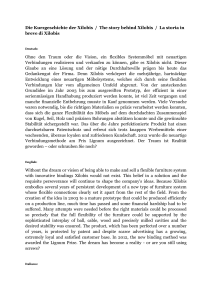
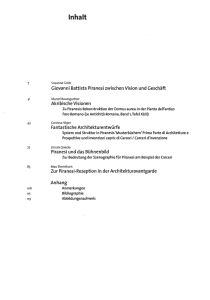
![Ricerca nr. 1 [MS WORD 395 KB]](http://s1.studylibit.com/store/data/000076742_1-2ede245e00e21c823e517529e1c3be46-300x300.png)
